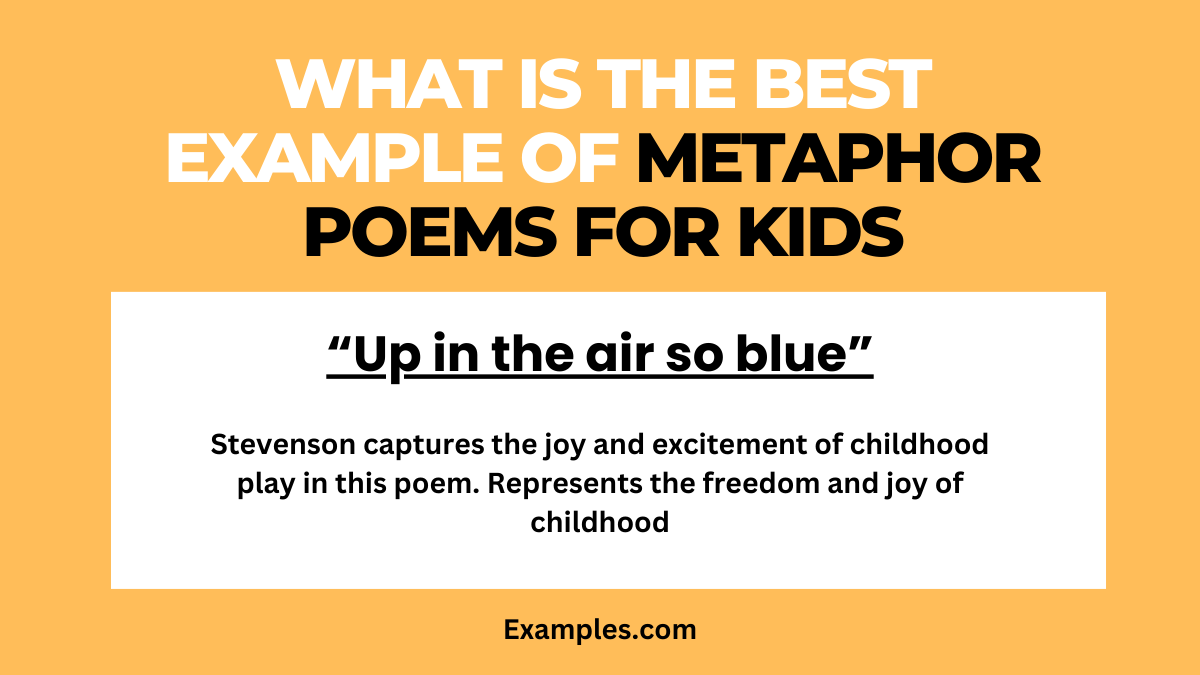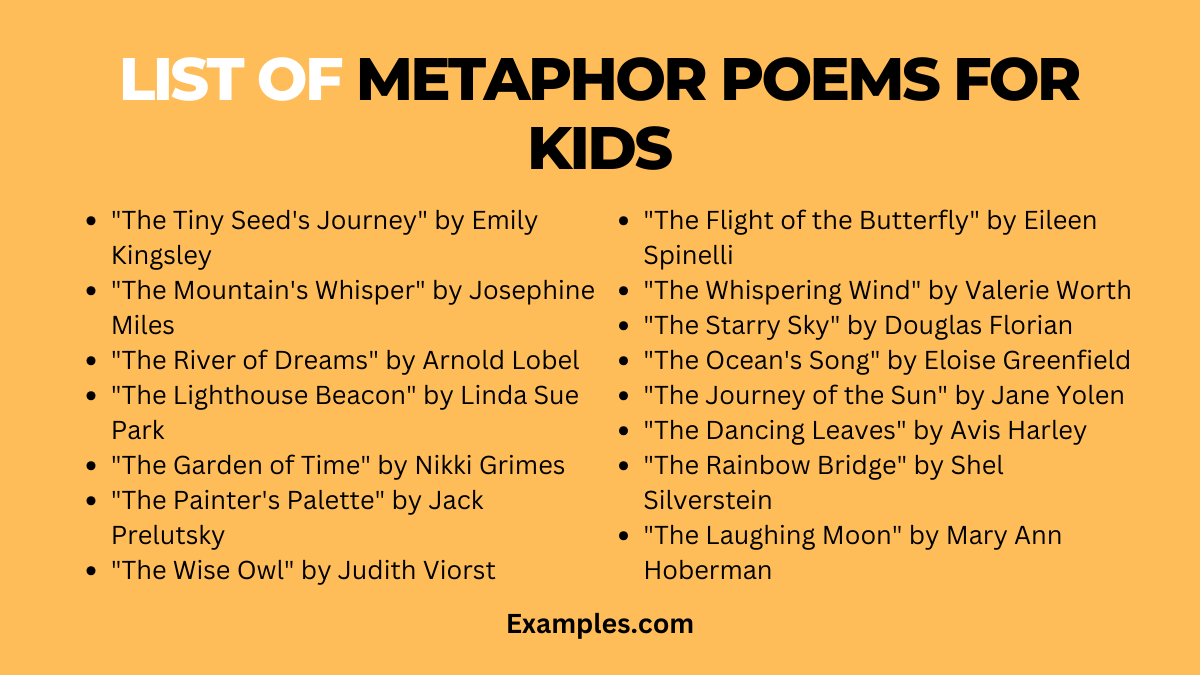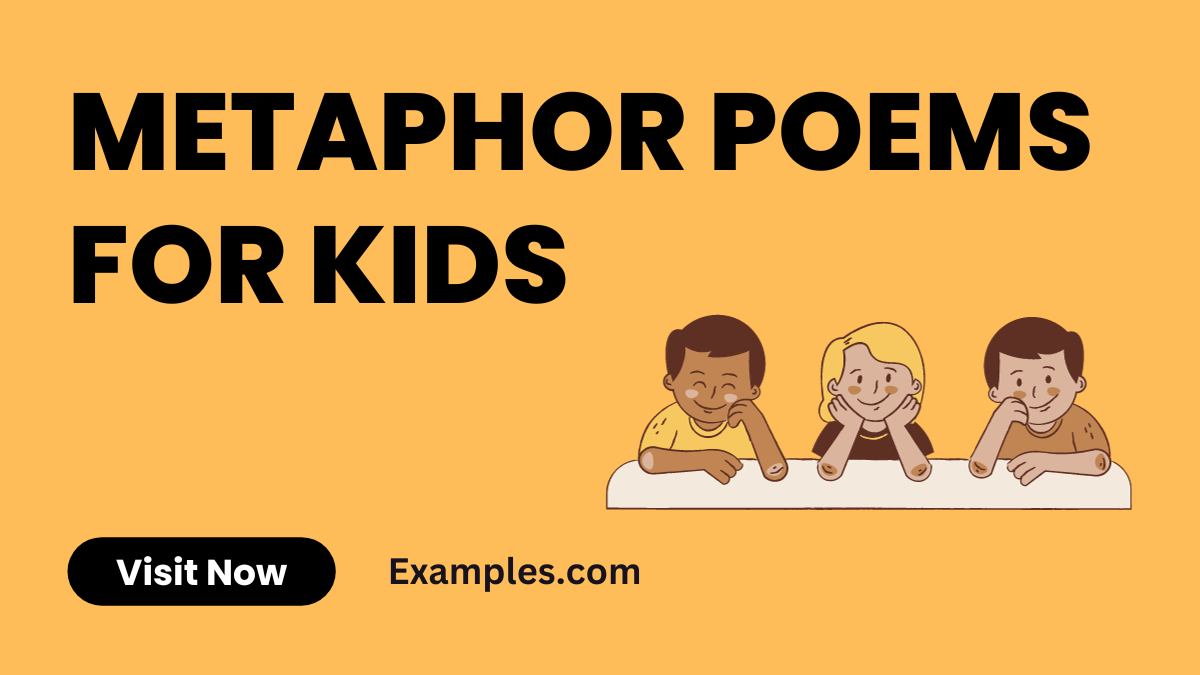Metaphor Poems for Kids
Metaphor poems offer a captivating way to enrich children’s linguistic skills. This guide delves into the vibrant world of metaphor examples, tailored to kindle young minds’ curiosity. We introduce metaphor poems as a creative tool, blending storytelling with learning. Each poem is not just a set of lines but a journey into the realm of imagination, encouraging kids to explore and interpret the world in new, exciting ways. This journey not only enhances their understanding of language but also nurtures their creative and critical thinking abilities. With carefully chosen examples, we aim to make metaphors a playful and engaging part of kids’ educational adventures.
Download Metaphor Poems for Kids PDF
What is the Best Example of Metaphor Poems for Kids

Discovering the best example of metaphor poems for kids involves exploring poems that are not only age-appropriate but also spark creativity and imagination. Such poems typically use everyday objects or experiences to illustrate more complex ideas, making them relatable and understandable for children. The best examples seamlessly blend fun and learning, allowing kids to delve into the world of metaphors while enjoying the beauty of poetry.
List of Metaphor Poems for Kids

1. “The Road Not Taken” by Robert Frost
This classic poem originates from Frost’s contemplation of life’s choices, symbolizing the crossroads everyone faces. It’s often used in educational settings to teach decision-making and self-discovery. Originating from Frost’s own contemplation of life’s decisions, it’s a perfect metaphor for schools and educational settings, teaching about decision-making and self-discovery.
Download Full Poem The Road Not Taken PDF
Metaphors:
- “Two roads diverged in a yellow wood” – Opening line: Represents life’s choices and the impact of decisions.
- “And sorry I could not travel both” – First stanza: Emphasizes the impossibility of experiencing every life opportunity.
- “I took the one less traveled by” – Last stanza: Symbolizes the choice of a unique path in life.
2. “Hope is the Thing with Feathers” by Emily Dickinson
This poem personifies hope as a bird, stands out as an easy metaphor. It’s used in therapeutic and educational contexts for its comforting imagery.
Download Full Poem Hope is the Thing with Feathers PDF
Metaphors:
- “Hope is the thing with feathers” – Opening line: Compares hope to a bird, suggesting its lightness and ability to uplift.
- “That perches in the soul” – First stanza: Implies that hope resides deep within the human spirit.
- “And sings the tune without the words” – Second stanza: Indicates hope’s ineffable quality, beyond verbal expression.
3. “Fog” by Carl Sandburg
Sandburg uses the metaphor of fog to describe the subtle, transient nature of some experiences. This poem is lauded for its simplicity and vivid imagery, making it a popular choice in metaphor poems for primary school.
Download Full Poem The Fog PDF
Metaphors:
- “The fog comes on little cat feet” – Opening line: Compares fog to a cat, highlighting its quiet, graceful arrival.
- “It sits looking over harbor and city” – Second line: Personifies fog as an observer, suggesting contemplation.
- “And then moves on” – Last line: Reflects the transient nature of certain moments or feelings.
4. “My Shadow” by Robert Louis Stevenson
Robert Louis Stevenson’s poem, which explores a child’s fascination with their shadow, is a prime example of metaphor poems for 3rd grade. It’s a favorite in primary education for its playful tone.
Metaphors:
- “He is very, very like me from the heels up to the head” – Early stanza: Suggests the shadow as a reflection of oneself.
- “And I see him jump before me, when I jump into my bed” – Mid poem: Illustrates the mimicry and constant presence of the shadow.
- “The funniest thing about him is the way he likes to grow” – Later stanza: Captures the changing nature of the shadow, and by extension, oneself.
5. “The Cloud” by Percy Bysshe Shelley
Shelley personifies a cloud, using it to explore themes of transformation and nature’s cycles. This makes it an excellent metaphor poem for 5th grade, utilized in literature classes for its rich imagery.
Metaphors:
- “I bring fresh showers for the thirsting flowers” – Opening stanza: Symbolizes the nurturing role of nature.
- “I am the daughter of Earth and Water” – Mid poem: Represents the cloud as a product of natural elements.
- “I change, but I cannot die” – Final stanza: Emphasizes the perpetual cycle of nature.
6. “The Tyger” by William Blake
Blake’s poem explores the duality of creation through the metaphor of a tiger. This poem is often included in metaphor poems for 6th grade literature classes for its philosophical depth and complexity.
Metaphors:
- “Tyger Tyger, burning bright” – Opening line: Symbolizes the fierce, vibrant force of nature.
- “What immortal hand or eye, Could frame thy fearful symmetry?” – First stanza: Questions the divine or powerful force behind creation.
- “Did he who made the Lamb make thee?” – Final stanza: Contemplates the contrasting aspects of nature and creation.
7. “The Swing” by Robert Louis Stevenson
Stevenson captures the joy and excitement of childhood play in this poem. Its rhythmic flow and relatable content make it a staple in metaphor poems for 4th grade and early education.
Metaphors:
- “Up in the air so blue?” – Opening line: Represents the freedom and joy of childhood.
- “And the river and the countryside” – Mid poem: Symbolizes the broadening of perspective and experiences.
- “Till I look down on the garden green” – Later stanza: Illustrates the changing viewpoints during the swinging motion.
Famous Metaphor Poems for Kids
1. “The Road Not Taken” by Robert Frost
“The Road Not Taken” is a renowned poem by Robert Frost, first published in 1916. This poem is a metaphorical reflection on life’s choices and their impacts. Originating from Frost’s personal experiences, it has become a classic in literature and education. It is widely used in schools to teach about decision-making, individuality, and the paths we choose in life, resonating with readers of all ages.
Metaphors:
- “Two roads diverged in a yellow wood” – Opening Line: This metaphor represents life’s choices. The ‘roads’ symbolize different paths or decisions we encounter, and the ‘yellow wood’ suggests the autumn of life or a time of change.
- “And looked down one as far as I could” – Line 4: Here, ‘looking down a road’ stands for contemplating a choice. It implies considering the possible outcomes before making a decision.
- “I took the one less traveled by” – Penultimate Line: This metaphor speaks to choosing a unique or unconventional path in life. It suggests the courage to follow a less popular or more challenging route, shaping one’s unique journey.
2. “Daffodils” by William Wordsworth
“Daffodils,” penned by William Wordsworth in 1804, is a beloved English poem. It reflects Wordsworth’s deep admiration for nature and its ability to uplift the human spirit. This poem is frequently used in educational settings to teach about the beauty of nature and metaphorical language. Its vivid imagery and simple language make it accessible and enjoyable for children, embodying the joy and tranquility nature can inspire.
Metaphors:
- “A host, of golden daffodils” – Line 4: This metaphor compares the multitude of flowers to a large, welcoming group. It personifies the daffodils, giving them a lively and joyous character.
- “Fluttering and dancing in the breeze” – Line 6: Here, the movement of the daffodils is likened to a dance. This metaphor gives the scene a dynamic and cheerful quality, illustrating nature’s playful side.
- “They stretched in never-ending line” – Line 9: The daffodils are metaphorically described as forming an infinite line, symbolizing the boundless beauty of nature and its ability to extend beyond human perception.
Best Metaphor Poems for Kids
1. “Mending Wall” by Robert Frost
“Mending Wall” by Robert Frost uses the metaphor of a wall to explore themes of boundaries and human relationships. Stemming from Frost’s rural experiences, it questions the necessity of barriers between people. Suitable for older kids, this poem is often analyzed in social and philosophical contexts, making it a great metaphor example for teaching.
Metaphors:
- “Good fences make good neighbors” – Line 27: This metaphor explores the idea that boundaries are essential for harmonious relationships.
- “Something there is that doesn’t love a wall” – Opening Line: This metaphor suggests a natural resistance to barriers and division.
- “And on a day we meet to walk the line” – Line 13: This line metaphorically represents the act of reviewing and maintaining personal boundaries.
2. “The New Colossus” by Emma Lazarus
“The New Colossus” by Emma Lazarus is inscribed on the Statue of Liberty, using metaphor to welcome immigrants to America. It portrays the statue as the ‘Mother of Exiles’, symbolizing a beacon of hope for those seeking a new life. This poem is emblematic of America’s identity as a land of freedom and opportunity, a perfect metaphor poem for middle school.
Metaphors:
- “Not like the brazen giant of Greek fame” – Line 1: This metaphor contrasts the Statue of Liberty with the Colossus of Rhodes, emphasizing a welcoming rather than formidable presence.
- “A mighty woman with a torch” – Line 6: The Statue of Liberty is metaphorically described as a guiding figure, leading people to safety and opportunity.
- “Mother of Exiles” – Line 6: This metaphor portrays the statue as a nurturing figure for those displaced from their homelands.
Metaphor Poems for Kids about Life
1. The Tiny Seed’s Journey
“The Tiny Seed’s Journey” is a delightful metaphor poem that narrates the life cycle of a seed. Originating from the concept of growth and resilience, it’s often used in educational settings to teach about life’s stages and persistence. It beautifully parallels a seed’s growth to a child’s life journey, emphasizing themes of patience and potential, making it a suitable metaphor poem for year 4.
Metaphors:
- “The brave little warrior” – Opening lines: This metaphor compares the seed to a brave warrior, symbolizing the courage and strength required to grow and thrive against odds.
- “Nature’s tiny umbrella” – Mid-poem: Referring to the seed’s protective cover, this metaphor illustrates the importance of safety and care in the early stages of growth.
- “A dance in the rain” – Towards the end: This metaphor depicts the seed’s sprouting as a joyful dance, symbolizing the celebration of new beginnings and life.
2. The Mountain’s Whisper
“The Mountain’s Whisper” is a metaphor poem that personifies a mountain to teach about life’s endurance and wisdom. Its origin lies in the majestic and timeless nature of mountains, often used in classrooms to discuss perseverance and the passage of time. This poem is a great addition to metaphor poems for year 5, inviting children to reflect on life’s consistent, enduring qualities.
Metaphors:
- “The ancient storyteller” – Opening stanza: The mountain is likened to an old storyteller, representing the accumulation of wisdom and history over time.
- “A guardian in the clouds” – Mid-section: This metaphor portrays the mountain as a protective figure, signifying stability and security in life.
- “A crown of snow” – Near the end: The snow-capped mountain is depicted as wearing a crown, symbolizing life’s achievements and the beauty of aging gracefully.
3. The River of Dreams
“The River of Dreams” is a metaphorical journey, reflecting on life’s ever-flowing and changing nature. Originating from the fluidity of rivers, this poem is popular for teaching kids about adaptability and the constant motion of life. Likening life’s experiences to a river’s journey, this poem is an excellent metaphor poem for year 6, teaching kids about adaptability.
Metaphors:
- “A winding path of whispers” – Early in the poem: The river’s path is compared to a series of whispers, signifying life’s quiet, subtle changes and secrets.
- “Mirror to the sky” – Midway through: This metaphor suggests that the river, like life, reflects our experiences and surroundings, showing how we are shaped by our environment.
- “Dance of the ripples” – Closing lines: The ripples in the river symbolize life’s small joys and the beauty of embracing change.
4. The Lighthouse Beacon
“The Lighthouse Beacon” uses the metaphor of a lighthouse to represent guidance and hope in life. The poem’s origin is rooted in the symbolism of lighthouses as beacons of safety. This poem is frequently used in school settings, making it an ideal metaphor poem for year 7.
Metaphors:
- “Guiding star on land” – Early in the poem: The lighthouse is likened to a star, symbolizing guidance and hope in navigating life’s challenges.
- “Sentinel of the shore” – Mid-poem: This metaphor portrays the lighthouse as a vigilant guardian, representing the role of guidance and protection in life.
- “Beacon of unwavering faith” – Towards the end: The steadfast light of the lighthouse symbolizes enduring faith and confidence through life’s journey.
5. The Garden of Time
“The Garden of Time” is a metaphorical poem that compares life to a garden. It originates from the idea of life being a collection of diverse experiences, much like a garden is a collection of different plants. This poem is a favorite for teaching about growth and diversity, making it a wonderful metaphor poem for year 8.
Metaphors:
- “Tapestry of blooms” – Opening stanza: The variety in a garden is compared to a tapestry, illustrating life’s rich tapestry of diverse experiences.
- “The wise old tree” – Middle of the poem: This metaphor uses the tree to symbolize knowledge and the passage of time in life.
- “The river of blossoms” – Near the end: Here, the blossoming flowers are likened to a river, depicting life’s continuous and flourishing nature.
How to write a Metaphor Poem for Kids?
Writing metaphor poems can be a fun and engaging way for kids to explore language and creativity. Metaphors are a great tool to express ideas and emotions in a vivid and imaginative manner. Below is a step-by-step guide to help kids craft their own metaphor poems.
Step 1: Understand What a Metaphor Is
First, it’s essential for kids to understand what a metaphor is. A metaphor is a figure of speech that describes an object, person, or situation as if it were something else, highlighting the similarities between the two. Unlike a simile, it does not use “like” or “as.” For example, saying “Time is a thief” is a metaphor that suggests time steals moments from our lives, even though it is not literally a thief.
Step 2: Choose a Topic or Theme
Encourage kids to pick a topic they are interested in or passionate about. It could be anything from nature, such as the sea or the sky, to emotions like happiness or anger. The choice of topic will guide the direction of their metaphor.
Step 3: Brainstorm Ideas
Have the kids brainstorm ideas about their chosen topic. If they’ve chosen ‘the sea,’ they might think of words like vast, deep, mysterious, or calm. These ideas will help in creating the metaphor.
Step 4: Find the Comparison
The next step is to find something to compare their topic to. For instance, if the sea is the topic, they might compare it to a mirror, reflecting the sky. The metaphor then becomes ‘The sea is a mirror, vast and reflecting.’
Step 5: Write the First Draft
Encourage kids to start writing their poem using the metaphor they’ve created. Remind them that it’s okay if it’s not perfect on the first try. The goal is to get their ideas down on paper.
Step 6: Use Descriptive Language
Advise them to add descriptive words to make their metaphor more vivid. For example, instead of just “The sea is a mirror,” they could write, “The sea is a shimmering mirror, under the bright sun.”
Step 7: Revise and Refine
After writing the first draft, it’s time to revise. They should read their poem aloud, see if it makes sense, and check if the metaphor is clear and effective. Encourage them to tweak words and phrases to make the poem flow better.
Step 8: Share the Poem
Finally, encourage kids to share their metaphor poem with others. They can read it to family members, friends, or even present it in class. Sharing their work can boost their confidence and inspire them to keep writing.
By following these steps, kids can learn to create engaging and imaginative metaphor poems. This activity not only improves their writing skills but also enhances their ability to think creatively and expressively.
In conclusion, this comprehensive guide offers a clear, step-by-step approach to help kids craft their own metaphor poems for kids. Through understanding metaphors, brainstorming, and creative writing, children can explore and express their thoughts vividly. This guide not only enhances their linguistic skills but also encourages imaginative thinking, making it a valuable resource for fostering creativity in young minds.


